Wool combs in the Viking Age - the evidence
We write a lot about wool combs and at the markets, we explain and demonstrate how they were used. But what is the actual evidence for those tools?
Finds from Scandinavia
Norway
A description of wool combs from the Viking Age can be found in Hoffmann's work from 1974 1 and 19912 . Marta Hoffmann describes the combs as “the most ancient tool for preparing wool for spinning that is known in the North”1 . She mentions finds from Norway and Iceland dated to the Viking Age as well as a depiction of St. Blasius' martyrdom on an altar from Paderborn, dated to the late 11th century, where he is tortured with wool combs2 . St. Blasius was the patron saint of the woolworkers.
More detailed information on the Norwegian wool combs which have been found in graves can be found in Petersen (1951)3 (in Norway it is more common to find tools for every day’s work in prehistoric burials than it is in Sweden or Denmark1 ). Petersen calls them flax heckles and flax combs (“linhekler og linkammer”). The main difference seems to lie in the number of tooth rows, flax heckles having two and flax combs having only one row. It has been argued, however, that many of those “flax” tools actually are wool combs1 . The reasons are that
- they often occur in pairs (for working flax, only one heckle is needed),
- they usually look different from heckles, and
- the geographical distribution does not correspond with the recorded evidence on the flax cultivation in Norway.
Pictures or drawings of some wool comb finds can be found online, e.g. in the digitalt museum. One pair, from Hyrt in Hordaland, had a single row of 20 teeth which had been slightly bent towards the top. The head is 14.5cm wide and rounded with an iron sheet around it 3 .
Another one, dated to "Iron Age", comes from Veka, Voss, Hordaland. It seems that here, only twelve teeth were set into the wooden part.
A third wool comb with remaining head from Rabstad, Hamar k., Hedmark, had been on exhibition in the Museum of Cultural History in Oslo in 2016. Some details can be found in the literature3 : The rectangular head is around 2cm thick, 15cm wide and 4cm deep. Two rows of 14-15 unbent teeth, protruding some 60-70mm from the head, are set into an iron sheet. The comb has been dated to the 10th century.
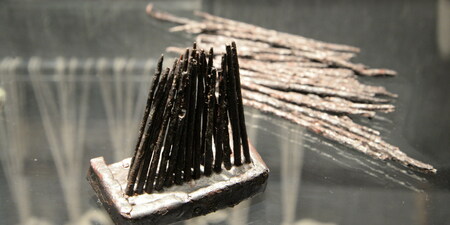
Of the 136 Late Iron Age wool comb (or flax heckle…?) finds from Norway listed in Petersen (1951) – of which many might only consist of a collection of iron teeth - some 10 are described with some detail:
- C. 5737. Prestegården, Å s., Lyngdal p., Vest-Agder. Only one heckle/comb was found. It was made of wood without any metal sheet riveted around it. No teeth are mentioned.
- St. 2562. Kirkhus, Årdal s., Hjelmeland p., Rogaland. One (?) heckle/comb made of wood. The head is round, 32cm wide and had one row of 34 teeth in it.
- St. 2579. Kirkhus, Årdal s., Hjelmeland p., Rogaland. One wooden heckle/comb. The head, which was not preserved completely, was around 23cm wide. No teeth are mentioned.
- St. 3712 a. Sandve, Høyland, Rogaland. Two wooden heckles/combs. One had 18 teeth in a rounded head, 3cm thick, 13cm wide and 3cm deep. The teeth were 90mm long. The second heckle/comb’s head is 4cm deep.
- B. 5910. Dale, Dale s., Fjaler p., Sogn og Fjordane. Two heckles/combs made of birch wood (“rødbjerk”), head and handle form a T-shape. The head is cylindrical, 15cm long and 3.5cm in diameter. 19 bent teeth stood in one row. There was no metal pate.
- T. 9268. Røttingsnes, Tingvoll s. og p., Møre og Romsdal. One (?) heckle/comb with a metal sheet around the head. The teeth (number unknown) portuded at least 70mm from the head.
- T. 1081. Austråt, Ørlandet s. og p., Trøndelag. One (?) heckle/comb, teeth protruding 63-64mm from the head.
- Unknown number. Marisletta, Tromsøysund s. og p., Troms. One (?) wooden heckle/comb with five teeth in a head measuring 6.8cm (width) and 3.7cm (depth). A metal sheet was wound around it.
- B. 9060. Haugateigen av Hopperstad, Vik s. og p., Sogn og Fjordane. Two heckles/combs with 20 teeth each.
- B. 9065. Helgheim av Nes, Stedje s., Sogndal p., Sogn og Fjordane. Two heckles/combs with 18 teeth each.
Of 116 graves where the sex of the deceased could be determined, 102 were women’s graves, the remaining 14 graves or 12% being men’s graves3 .
The bulk of Viking Age wool comb finds we are aware of comes from Norway. Apart from the ones described above there may be many more in the Norwegian museum collections, perhaps "disguised" as flax tools. One such an example can be found in the online collection of NTNU University's museum, where it is listed as a "flax ripple". The alternative interpretation - the tool really being a wool comb - can be found in the item's description. The facts that the teeth are quite long (up to 11cm), that they are tapered towards the tip and slightly bent all speak for the wool comb interpretation. The wooden handle seems to be around 3cm thick.
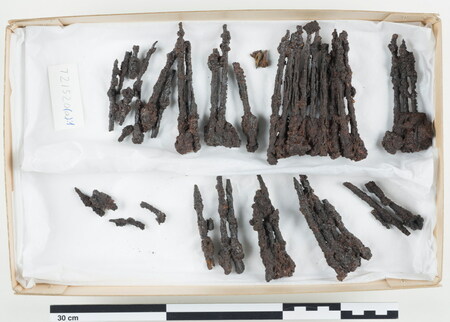
There are more wool combs to be found in Norway. During excavations in Trøndelag in 2020, another comparatively well preserved pair was unearthed in a woman's grave. Unfortunately, we have not yet been able to find any specific details of this particular pair (measurements, wood preserved, if so, what type of wood?).
Denmark
The remains of two wool combs have been found at the Danish fortress Fyrkat, which has been dated to the second half of the 10th century, at the outer side of a rampart at the site where a large fire has occurred in former times4 . One of the combs is almost complete, the charred handle made of lime wood (Tilia) fragmented, but still preserved. It is ca. 17.5 cm long, the head is 9.9cm wide. The handle gradually gets wider towards the head. The iron teeth, of which 14 survived, were driven through a 2.2cm wide iron sheet. Under the sheet, they protrude some 2.3cm. The iron sheet is broken off at one end and folded over the wood at the other. It is not certain whether the head is complete or not. No traces of a second row have been found on this comb, but it has been suggested that another collection of loose teeth might originally have belonged to it4 .
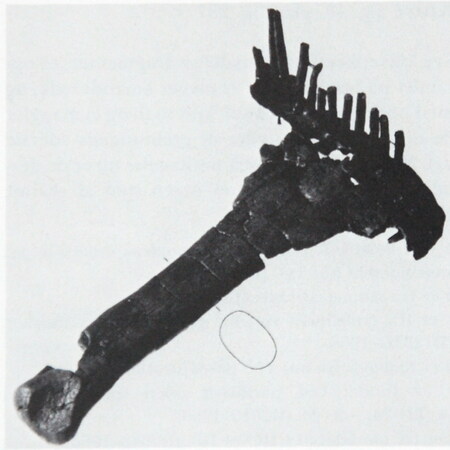
The other wool comb from Fyrkat is in a worse state than the first. Some 8cm of wooden handle close to the iron teeth are preserved and show that it had the same shape as the first comb. It too was made of Tilia. Apart from this, there are three loose collections of rusted iron teeth. The first tooth collection consists of wooden remains and 14 rounded teeth. The fragment is around 8cm wide. The best preserved teeth are slightly bent and 12cm long, but only 9cm are on the "upper" side of the iron sheet; 2cm are located inside the wood and another 1cm protrudes from the wood. The base of the teeth are broadened like a nail's head. It is not likely that the teeth would have been protruding 1cm at the underside of the comb when it was used and I guess that the wood simply shrunk due to the fire and perhaps the time lying in the ground. The second conglomeration consists of another five teeth and is ca. 3.2cm wide. A piece of wood is still attached to it. The third conglomeration of teeth suggests that the combs might have had two or more rows originally. It is not clear whether one of the loose tooth collections mentioned above might have belonged to the first comb4 .
At present day Århus, south of Skt. Clemens, an excavation took place during the 1960’s which revealed, among many other finds, the remains of a grub hut dated to the 10th century5 . It had burnt down in antiquity and the fire somehow preserved many textile fragments as well as the tools for working the fibers and producing those textiles. Among them was a conglomeration of iron that turned out to be a set of tools for preparing fibers for spinning. They have been recorded as flax heckles and portrayed as such in the Viking Age exhibition at Moesgård Museum (in 2018), but it has also been stated that they might have been wool combs5 . Only the metal parts have survived, the wooden handle and head are gone. The rectangular head was bound with an iron sheet around 1mm thick. It (and therefore the head) measured about 10cm in width, 4.5cm in depth and 1.5cm in thickness. The combs had two rows of 12 and 11 iron teeth, respectively, whose “free” part was around 7.5cm long. They pierce through the upper part of the metal sheet but only touch the lower one. The distance between the teeth was around 3-5mm. Both combs were so similar in design that they would have made a functional pair.
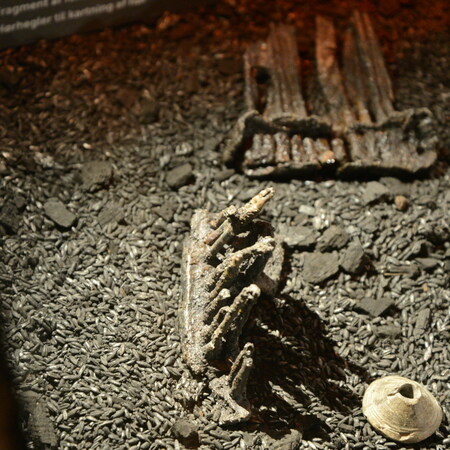
Wool comb teeth from Scandinavia
Apart from those mentioned above, (almost) complete wool combs are rarely found. The iron teeth, however, sometimes appear in publications dealing with Viking Age textile production, but even those are rare. One explanation might be that old wool comb teeth were reused as nails or other simple iron objects6 .
Another problem is the similarity between wool comb teeth and the teeth belonging to a flax heckle. Telling those tools apart is even more challenging when the production of both woolen and linen fabric was possible at a site, as for example in Anglo Saxon York. Here the two types of artifact were distinguished as follows7 : Wool comb teeth have a typical length of 90-110mm (in Norway up to 130mm), they are rounded or rounded-rectangular in diameter and slightly tilted towards the tip. The length and shape of a wool comb tooth was comparatively standardized, whereas length and shape of flax heckle teeth were more variable (for more on the wool comb finds from York, see “Finds from outside Scandinavia”). Flax heckle teeth from York were between 70 and 103mm long, not tilted towards the tip but straight and rectangular, only sometimes rounded, in diameter. Most of all they had to be sharp in order to tear into the fiber.
Norway
Around 20 wool comb teeth were on exhibition in the Museum of Cultural History in Oslo in the year 2016. They are from Ås, Ullensaker k., Akerhus and are dated to the 9th century. Wool comb teeth (without the handle) are the most common remnants of wool combs (or flax heckles…) in Norway3 .
Sweden
When Eva Andersson Strand assessed the textile tools found in Löddeköpinge and re-registered those found in Birka and Hedeby6, 8 , she defined that a wool comb tooth should only be registered as such if it is over 50mm in length and 4-6mm in thickness, unless several teeth were found in the same feature. She was able to register 18 iron teeth from Birka as wool comb teeth.
In some of the sunken floor huts in Löddeköpinge, Skåne, wool comb teeth were found6 . Two teeth were dated to the 9th century, six to the period between 900-1050. One was found in the filling and might be dated to the latter period as well.
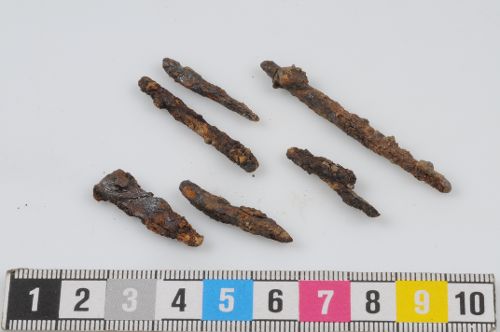

Denmark
Another find was made at Lisbjerg, close to present day Aarhus 9 . A large number of sunken floor huts, among other buildings, was excavated there, many of them dating to the 8th-10th century. In 17 sunken floor huts loom weights were found. Other textile tools like spindle whorls were found as well, which might indicate some textile production of larger scale. In one sunken floor hut, an iron spike was found which had been identified as either a wool comb tooth or a flax heckle tooth. The evidence for a wool comb is very vague, unfortunately.
At the Viking Fortress Trelleborg, dated to the late 10th century, a collection of iron teeth of variable length (8-12cm) was found inside the ringwall in the South-East10 . They have been interpreted as originating from a flax heckle, but in my (and some other author’s4 ) opinion there is a possibility that they originate from a wool comb. Without more information on their shape, however, it’s impossible to come to a definite conclusion.
Germany
Although many textile tools were found in Hedeby, the excavations produced no wool comb teeth, which might be due to the preservation conditions for iron11 . One tool from Hedeby, a metal sheet with two rows of punctured holes as well as several teeth, could have been used as a wool comb. It was, however, classified as a flax heckle due to flax fibers between the teeth11 .
Finds from outside Scandinavia
Eastern Europe
Another comb has been found at the piast settlement Ostrów Lednicki, Poland12 . It dates to the 10th century. It is listed as a "weaving comb" in the publication, however, the length and position of the teeth make it more likely to be a wool comb or a heckle. The ca. 20 teeth, positioned in a double row, are a little bit longer than 5cm. The head part and the handle are surprisingly well preserved. The head measures around 6cmx7cm (?), the handle around 14-15cm. The wood has been identified as maple (Acer sp.)13
British Isles
The excavations at Coppergate, York, produced wool comb fragments and several teeth14 . One wool comb consists of two fragments of a binding sheet of iron which was originally wrapped around a wooden board and secured with iron nails. One fragment has eight iron teeth (105mm long) still attached in two rows, the other fragment has only two teeth and seven partial holes in the same row. The head was approximately 170mm long, 46mm wide and 23mm thick. Two additional teeth belonged to this comb but are not attached anymore. They were 105mm long and 5mm thick. The artifact had been identified as a wool comb because of hair fibers found at the base of the teeth. A second fragmentary binding sheet had eight rectangular holes pierced through it. It is 51mm long and 39mm wide, the holes are 4mm wide. The binding sheets are dated to between the late 10th and mid-11th century.
185 iron spikes from Coppergate were identified as wool comb teeth because of their similarity to the teeth from the iron sheets, although their characteristics might point to them being heckle teeth as well. They can be divided into two groups: One with a rounded or rounded-rectangular cross section, one with a rectangular or square cross section. They vary in length, but ca. 90% are between 75mm and 115mm long. They were found for all periods with a marked concentration (some 40%) dated to the period between AD 975-1050.
Among the earliest Viking Age deposits of a settlement at Jarlshof, Shetland Islands, was a naturally T-shaped piece of antler with 17 grooves which would originally have held at least one row of iron teeth15 . The handle was some 114mm long and the head around 140mm wide. The head is broken towards the front, so it cannot be established whether there was a second row of teeth. The tool has been identified as a heckle, but has been brought into the context of wool combs as well4 .
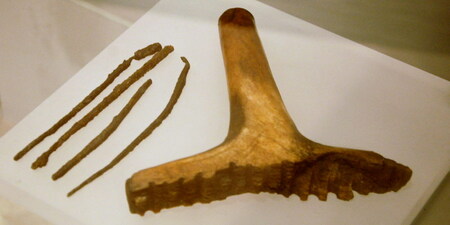
Thoughts on the distribution of wool comb finds
Perhaps wool combs are more likely to be found at places of industrial textile production or places with a social class present that has need of high-quality textiles? The scale of textile production was very large at Löddeköpinge and even grew during the Viking Age, probably due to political changes in Denmark6 . The grub huts from Lisbjerg (Denmark) also suggest a textile production covering more than just basic household needs. A textile production of a perhaps somewhat lower, but still considerable scale has been shown to have existed in Birka as well8 16 , even though no grub huts with textile tools have been excavated so far, as was the case in Löddeköpinge. Some textile production had been taken place at the fortress of Fyrkat, with a set of wool combs as well as twelve spindle whorls and the remains of at least ten loom weights; some of the graves indicate the presence of a social elite 4 . At Trelleborg the general situation might have been similar and the number of textile tools is even greater, with 39 spindle whorls, 40 loom weights (although the distribution of the loom weights suggests that most of them were in use when the fortress no longer fulfilled its original purpose), 15-18 scissors and 50 needles10 . Norway has been suggested as the origin of the diamond twill of the "Birka type"17 . In fact, the distribution of medium to fine diamond twills from the Viking Age over the country seems to correlate well with the distribution of wool comb finds3 17 . And the wool comb finds from Poland and England, too, come from larger settlements, in the case of York even a large town.
To disprove the hypothesis, it would be useful to actively look for the absence of wool combs at greater settlements with evidence of significant textile industry. One example would be Hedeby, where over 930 spindle whorls, 36 spindle rods, 4000 fragments of loom weights and many other tools needed for finishing of cloth and making of garments have been registered8 , but not a single wool comb. The presence of wool combs at sites of more domestic character could potentially disprove the hypothesis as well, since this would make those tools everyday objects without any special implications for the scale of textile production at a site. If one assumes that the antler tool from Jarlshof (Shetland Islands) was indeed a wool comb, this would be such a case. The early phase of the Viking Age settlement was dominated by finds suggesting a predominantly rural character15 .
References:
- Hoffmann, Marta, The Warp-weighted Loom: studies in the history and technology of an ancient implement. Robin and Russ Handweavers, 1974.
- Hoffmann, Marta, Fra fiber til tøy. Tekstilredskaper og bruken av dem i norsk tradisjon, 1991.
- Petersen, Jan, Vikingetidens redskaper. No. 4. I kommisjon hos J. Dybwad, 1951.
- Roesdahl, Else., Fyrkat. En jysk vikingeborg II: Oldsagerne og gravpladsen. 1977.
- Andersen, Henning Hellmuth, Peter J. Crabb, and Hans Jørgen Madsen., Århus Søndervold: en byarkæologisk undersøgelse. na, 1971.
- Andersson, Eva, Textilproduktion i Löddeköpinge - Endast För Husbehov?. Institute of Archaeology, University of Lund, 1999.
- Rogers, Penelope Walton, Textile production at 16-22 Coppergate. York Archaeological Trust, 1997.
- Andersson, Eva, Tools for Textile Production–from Birka and Hedeby. 2003.
- Birch Iversen, Rasmus, Samlet beretning for FHM 5312 Elmehøjsager III, FHM 5441 Haldager II, FHM5580 Elmehøjsager IV, Lisbjerg sogn, Vester Lisbjerg herred, tidl. Århus amt. Sted nr. 15.06.04. Sb.nr. 166; 167; 173. Moesgård Museum d. 11-05-2017
- Nørlund, Poul., Trelleborg. Nordiske Fortidsminder IV, 1. Det Kgl. Nordiske Oldskriftselskab: København 296 (1948). p. 142.
- Westphalen, Petra, Die Eisenfunde von Haithabu. Vol. 10. Wachholtz Verlag, 2002.
- Poláček, Lumír (Hrsg.), Das wirtschaftliche Hinterland der frühmittelalterlichen Zentren - Internationale Tagungen in Mikulčice VI, Brno 2008, 109-125
- Stępnik, Tomasz, Średniowieczne wyroby drewniane z Ostrowa Lednickiego. Studia Lednickie 4, 1996: 261-296.
- Ottaway, Patrick., Anglo-Scandinavian ironwork from 16-22 Coppergate, York: c. 850-1100 AD. Diss. University of York, 1989.
- Hamilton, John Robertson Campbell., Excavations at Jarlshof, Shetland. Vol. 1. HM Stationery Office, 1956.
- Andersson Strand, Eva, The organization of textile production in Birka and Hedeby. In S. Sigmundsson (Ed.), Viking Settlements and Viking Society, Papers from the Proceedings of the Sixteenth Viking congress (pp. 1-17), 2011.
- Bender Jørgensen, Lise, Prehistoric Scandinavian textiles. Det Kongelige Nordiske Oldsdriftselskab, 1986.